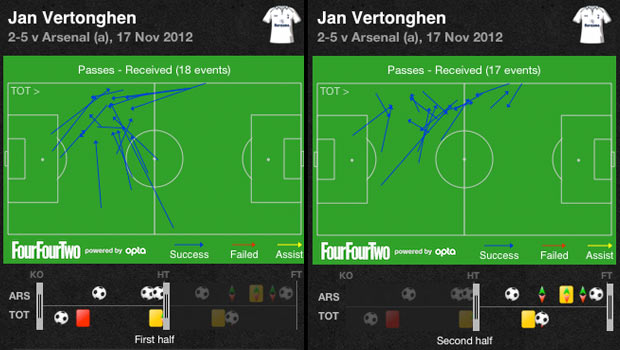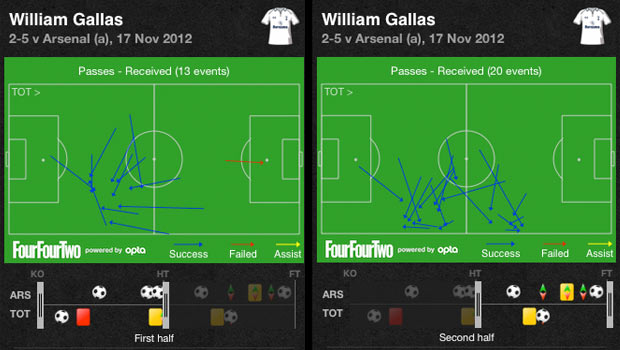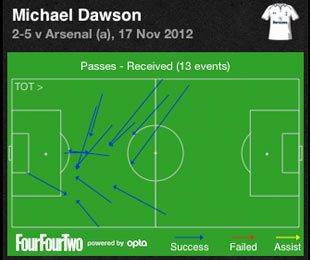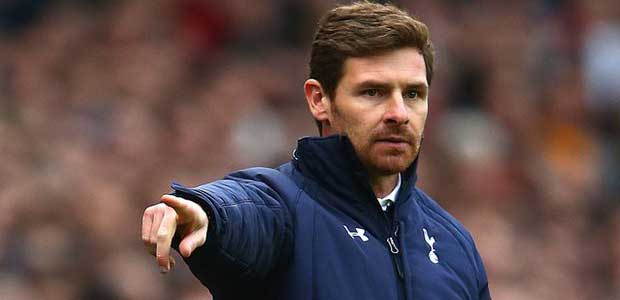Despite coming off the wrong side of the score line at the Emirates on Saturday, there were a number of things that Spurs could be praised for. One of these was the tactical switches by Andre Villas-Boas in an attempt to never give up the game.
The use of a back three in the second half allowed Spurs to be more aggressive with ten men. The match went from 3-1 to 4-2 and Tottenham had chances to narrow the margin even further.
When healthy, we have five centre backs in our squad with Vertonghen, Gallas, Dawson, Kaboul and Caulker. So could Spurs possibly switch to a back three?
Spurs back three against Arsenal
Down to ten men and chasing the game against the Gooners, Andre Villas-Boas brought on Michael Dawson to sit in the middle of a back three. Dawson is our best defender for winning headers, but also our slowest over the ground – arguably with William Gallas. So to sit him here where he is slightly deeper than the other two was a good move.
If we just focus on the three centre backs, we can see how dropping Michael Dawson in the middle allows the other two to move up the field.
If we look at both Jan Vertonghen and William Gallas on Stats Zone, we can see the difference in their positioning after Spurs moved to a back three.
Jan Vertonghen receives all passes to him in our half of the field in the first 45 minutes. He takes possession in central areas and moving out in to the left back zone when part of a back four.
In the second half after Spurs move to a back three, despite only having ten men, Vertonghen is freer to move up the field and receives the ball in wider areas.

We see a similar advancement in the position of William Gallas despite the fact that we are playing with ten men.
In the first half, the Frenchman receives the ball deep in our half in the central and right back zones, whereas the shift to a back three means he can get forward more.

Michael Dawson just sits deeper than the other two and is the out ball to retain possession by moving it across the backline.

Offensively it allowed us to get forward more and stop the Arsenal full backs advancing up the pitch by using attacking players in the wingback positions.
However, this meant that Gareth Bale and Aaron Lennon didn’t play as much of a role on the defensive side of the ball, as wingbacks should. Arsenal were able to take advantage of this lack of cover in the wide zones and this is where their two second half goals came from. Overall though, the pressure was reduced after we switched to a back three.
After having 7 shots in the first half, of which 5 were on target, Arsenal took 6 shots in the second, of which 2 were blocked and only 2 were on target.
Jan Vertonghen and William Gallas cleared 4 of 13 attempts in the first half as part of a back four. With Michael Dawson dropping in to create a back three, the trio successfully cleared 5 of 9 attempts in the second.
Advantages of Spurs moving to a back three
The tactical shift to a back three could create a number of advantages.
First of all it would give us a stronger defensive presence in the centre of the park. We have five centre backs in our squad and it would allow us to make best use of them. Michael Dawson is strong in the air, but slow over the ground. While he may struggle to play in a back four employing a high line, he may be better deployed in a three where he is sweeping behind the other two.
It would also permit Jan Vertonghen to get forward more. The Belgian likes to get up the field as we’ve seen from his exertions at left back and also his marauding goal at Old Trafford.
A back three also provides more cover for the wingbacks when played with eleven men. Kyle Walker has had a somewhat shaky start to the season this term. Among some of the factors I’ve previously looked at on why we shouldn’t get down on Kyle, was the distance between him and William Gallas, plus his play against indirect opponents. A move to a back three would give Kyle more cover from his centre backs in both these situations.
It also permits us to have the choice of two centre forwards on the field, allowing us to get both Emmanuel Adebayor and Jermain Defoe upfront.
Disadvantages of moving to a back three
No formation is without its drawbacks and whilst the shift to a back three would create some advantages for Spurs, it would also mean some disadvantages as well.
Firstly, we’ve been playing with two full backs and also two wide forwards. This allows us to get maximum speed on the pitch, with Walker and Lennon down the right, whilst Bale and Assou-Ekotto can get down the left.
A move to a back three would mean either going with two defensively minded wingbacks in Walker and Assou-Ekotto. A mixture of a defensively minded player like Walker, with an attacker in Bale is also an option. Or, an aggressive attacking combination as we saw at the Emirates in Bale and Lennon. The amount of choice is positive, but the loss of personnel and pace is a negative.
Broadly speaking, teams like to keep a spare man at the back. When the opposition are playing with one up, then you should have two centre backs so you always have 2v1 and a man over. Having a back three in this case would theoretically mean a suboptimal use of resources. If a team plays two up, or with a high front three though, then this system could prove useful.
As we saw against Arsenal, if the wingbacks are pushed on, then you can concede chances and crosses from wide areas. Of course we were chasing the game with ten men in this match, but Wigan who also use a back three, have allowed the fourth most crosses in the Premier League this season. Only Fulham (325), West Brom (364) and Aston Villa (365) have allowed more balls in to the box than Wigan’s 305 this season, although they do have three centre backs to deal with these.
Could Spurs move to a back three?
With our abundance of centre backs, moving to a back three is an option for Andre Villas-Boas. It also gives him the choice to go with two strikers to get Jermain Defoe and Emmanuel Adebayor on the park and not be light in the centre of midfield.
When a number of teams went to three centre backs in the 1990s they would use more defensive players as wingbacks, creating almost a back five. Nowadays most proponents combine a more defensively minded player with an attacking one, but this isn’t always the case.
If Spurs switched to a back three, then it would require the sacrificing of some of our wide players, which is often where we gain an advantage. It is for this reason that I could only see us playing this system when we are up against a weaker opponent and trying to get an extra striker on the field, but don’t want to go 4-4-2. It could also be used against teams that have one or two big men up top that they hit aerially – West Ham with Andy Carroll and Kevin Nolan for example.
Although not a perfect system, three men at the back is an option for Spurs this season and I wouldn’t bet against seeing it again.

Good article, a back three could be an option. Especially because our full-backs have been very average this season/injured, we could opt for a back three because we do have some quality CB’s.
Great article and totally agree that it could work, imagine a team like this, pretty solid. Definitely nothing would be able to get through the middle.
Loris/Friedel
Kaboul Caulker Vertonghen
Parker Sandro
Bale Lennon
Dembele
Ade Defoe